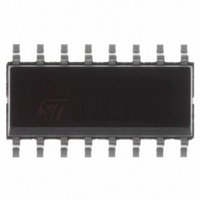L6566B STMicroelectronics, L6566B Datasheet - Page 21

L6566B
Manufacturer Part Number
L6566B
Description
IC CTRLR OVP OTP UVLO HV 16SOIC
Manufacturer
STMicroelectronics
Datasheet
1.L6566BTR.pdf
(51 pages)
Specifications of L6566B
Output Isolation
Isolated
Frequency Range
10 ~ 300kHz
Voltage - Input
8 ~ 23 V
Power (watts)
750mW
Operating Temperature
-40°C ~ 150°C
Package / Case
16-SOIC (0.154", 3.90mm Width)
Output Current
800 mA
Output Power
750 mW
Input Voltage
8 V to 23 V
Operating Temperature Range
- 40 C to + 150 C
Mounting Style
SMD/SMT
Duty Cycle (max)
75 %
Selectable Multi-mode Operation
fixed frequency or quasi-resonant
For Use With
497-6452 - BOARD EVAL FOR L6566B497-6451 - BOARD EVAL FOR L6566B497-6450 - BOARD EVAL FOR L6566B497-6449 - BOARD EVAL FOR L6566A
Lead Free Status / RoHS Status
Lead free / RoHS Compliant
Available stocks
Company
Part Number
Manufacturer
Quantity
Price
Part Number:
L6566B
Manufacturer:
ST
Quantity:
20 000
Part Number:
L6566BHTR
Manufacturer:
ST
Quantity:
20 000
Part Number:
L6566BTR-13
Manufacturer:
ST
Quantity:
20 000
L6566B
5.2
Zero current detection and triggering block; oscillator block
The zero current detection (ZCD) and triggering blocks switch on the external MOSFET if a
negative-going edge falling below 50 mV is applied to the input (pin 11, ZCD). To do so the
triggering block must be previously armed by a positive-going edge exceeding 100 mV.
This feature is typically used to detect transformer demagnetization for QR operation, where
the signal for the ZCD input is obtained from the transformer’s auxiliary winding used also to
supply the L6566B. The triggering block is blanked for T
turn-off to prevent any negative-going edge that follows leakage inductance
demagnetization from triggering the ZCD circuit erroneously.
The voltage at the pin is both top and bottom limited by a double clamp, as illustrated in the
internal diagram of the ZCD block of
located at 5.7 V, while the lower clamp is located at -0.4 V. The interface between the pin
and the auxiliary winding will be a resistor divider. Its resistance ratio will be properly chosen
(see
will be such that the current sourced and sunk by the pin be within the rated capability of the
internal clamps (± 3 mA).
At converter power-up, when no signal is coming from the ZCD pin, the oscillator starts up
the system. The oscillator is programmed externally by means of a resistor (R
from pin OSC (13) to ground. With good approximation the oscillation frequency f
Equation 2
(with f
at the end of the first oscillator cycle, being zero the voltage on the ZCD pin, the MOSFET
will be turned on, thus starting the first switching cycle right at the beginning of the second
oscillator cycle. At any switching cycle, the MOSFET is turned off as the voltage on the
current sense pin (CS, 7) hits an internal reference set by the line feedforward block, and the
transformer starts demagnetization. If this completes (hence a negative-going edge appears
on the ZCD pin) after a time exceeding one oscillation period T
turn-on, the MOSFET will be turned on again - with some delay to ensure minimum voltage
at turn-on – and the oscillator ramp will be reset. If, instead, the negative-going edge
appears before T
after T
drain ringing cycles will be skipped (“valley-skipping mode”,
frequency will be prevented from exceeding f
Section 5.11: OVP block on page 35
osc
osc
in kHz and R
will turn-on the MOSFET and synchronize the oscillator. In this way one or more
osc
has elapsed, it will be ignored and only the first negative-going edge
T
in kΩ). As the device is turned on, the oscillator starts immediately;
Figure 8 on page 20
f
osc
) and the individual resistance values (R
≈
osc
2
R
⋅
.
10
T
3
BLANK
. The upper clamp is typically
Figure 9
= 2.5 µs after MOSFET’s
osc
= 1/f
Application information
) and the switching
osc
from the previous
T
) connected
osc
Z1
, R
will be:
Z2
21/51
)













